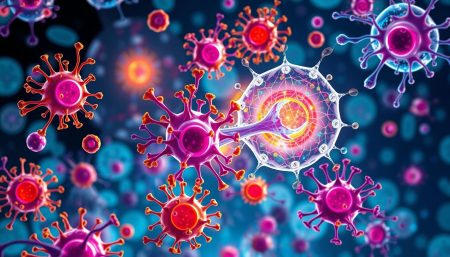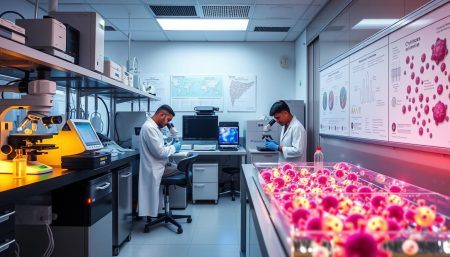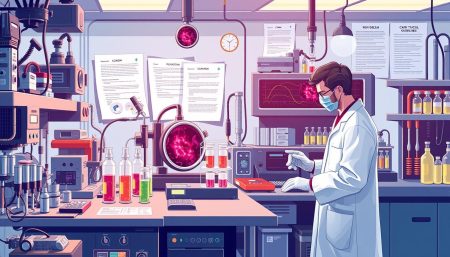Getting a prostate cancer diagnosis can feel scary. It’s important to know about the treatments available. This guide will help you understand your options, so you can make the best choices for yourself.
Today, there are many ways to treat prostate cancer. These include active surveillance and advanced therapies. Each treatment is chosen based on your cancer stage, health, and what you prefer. Let’s explore the different ways to fight prostate cancer together.
Understanding Prostate Cancer Treatment: A Comprehensive Overview
Prostate cancer treatment options depend on several factors. Doctors look at the cancer stage, the patient’s health, and what the patient prefers. Knowing these helps patients make better choices about their care.
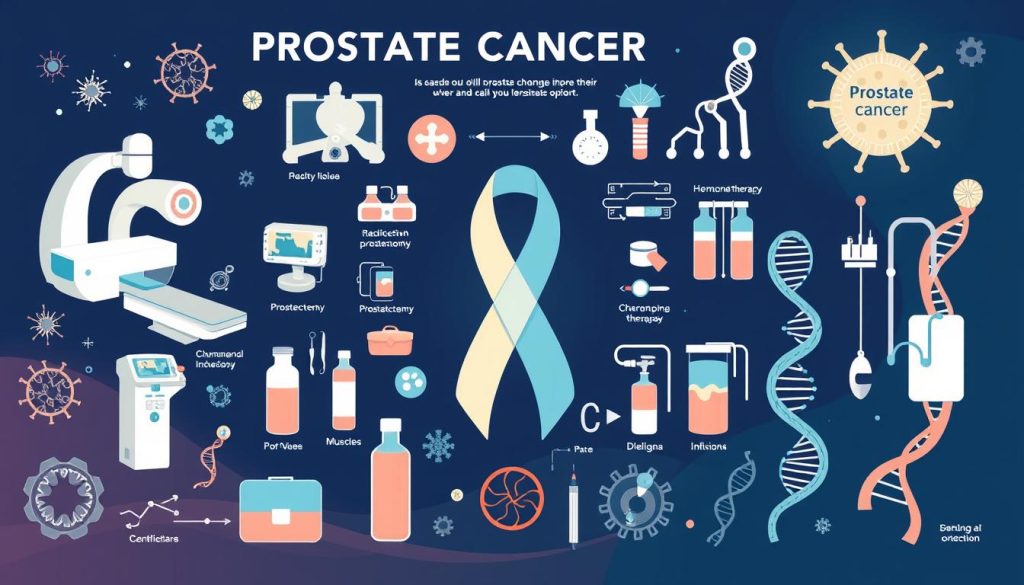
Stages of Prostate Cancer and Treatment Selection
The stage of prostate cancer is key in choosing treatment. Early cancers might get active surveillance or localized treatments. But, advanced cancers need stronger treatments. Prostate cancer survival rates get better with early detection and correct staging.
Risk Assessment and Treatment Planning
Doctors look at risk factors to plan treatments. They check PSA levels, Gleason score, and tumor size. Low-risk patients might choose watchful waiting, while high-risk ones might get combined therapies. This way, treatments are more effective and have fewer side effects.
Role of Healthcare Team in Treatment Decisions
A team of doctors works together for better care. Urologists, oncologists, and radiation specialists help decide treatments. They think about the patient’s health, lifestyle, and goals. This team ensures patients get the best care for their cancer journey.
“Empowering patients with knowledge about their condition and treatment options is key to successful outcomes in prostate cancer care.”
What Is The Treatment For Prostate Cancer: Primary Treatment Options
Men with prostate cancer have many treatment options. The right choice depends on the cancer’s stage, the patient’s health, and personal wishes. Let’s look at the main treatments.
Active Surveillance and Watchful Waiting
For cancers that grow slowly, active surveillance is often suggested. It means regular check-ups and tests to watch the cancer. Watchful waiting is less frequent and is for older men or those with other health problems.
Radical Prostatectomy: Surgical Approaches
Prostate surgery means taking out the whole prostate gland. It can be done in several ways: open surgery, laparoscopic, or robotic-assisted surgery. Each method has its own benefits and drawbacks, which patients should talk about with their doctor.
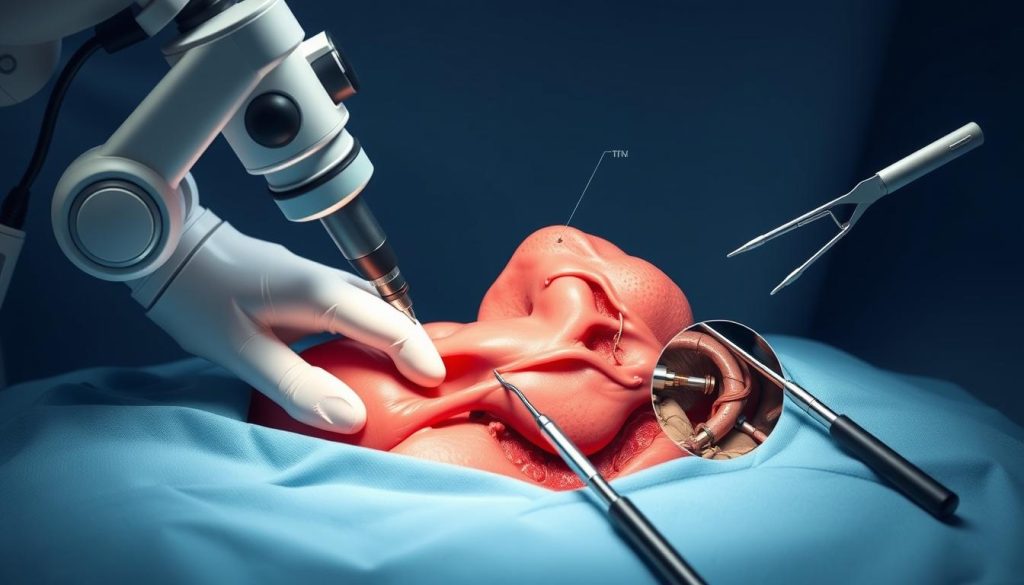
External Beam Radiation Therapy (EBRT)
EBRT uses high-energy beams to kill cancer cells. It’s given over weeks, with small doses each day. This treatment targets the cancer without harming too much of the surrounding tissue.
Brachytherapy: Internal Radiation Treatment
Brachytherapy puts radioactive seeds inside the prostate. This method gives a strong dose of radiation to the cancer while protecting the healthy tissue around it.
| Treatment | Pros | Cons |
|---|---|---|
| Active Surveillance | Avoids treatment side effects | Risk of cancer progression |
| Prostate Surgery | Removes cancer completely | Risk of urinary and sexual side effects |
| External Beam Radiation | Non-invasive | Daily treatments for several weeks |
| Brachytherapy | Highly targeted radiation | Requires anesthesia for seed placement |
Advanced Therapeutic Approaches for Prostate Cancer
When prostate cancer gets worse, stronger treatments are needed. Advanced treatments offer hope for those with aggressive or spreading cancer. These new methods aim to slow cancer growth and enhance life quality.
Chemotherapy is a key treatment for advanced prostate cancer. It uses strong drugs to kill cancer cells everywhere in the body. Though side effects can be tough, newer methods have made it better.
Immunotherapy is a new and exciting field. It uses the body’s immune system to fight cancer cells. Vaccines and checkpoint inhibitors are showing great promise in trials.
Targeted therapies are another big step. These drugs target specific genetic changes or proteins that help cancer grow. They can be more effective and less harmful than older treatments.
“Advanced prostate cancer treatments have come a long way. We now have more tools than ever to fight this disease and give patients hope for longer, better lives.”
Research keeps bringing new combination therapies. These use different treatments together to fight cancer from all sides. This approach may lead to better results and longer lives.
Hormone Therapy and Systemic Treatments
Prostate cancer treatment often involves systemic approaches that target cancer cells throughout the body. These treatments play a crucial role in managing advanced stages of the disease.
Androgen Deprivation Therapy (ADT)
Hormone therapy for prostate cancer, also known as ADT, is a cornerstone treatment. It works by reducing testosterone levels, which fuels prostate cancer growth. ADT can be administered through injections, pills, or surgical procedures.
Chemotherapy Protocols
Chemotherapy uses powerful drugs to kill cancer cells. For prostate cancer, docetaxel and cabazitaxel are common choices. These medications are typically given in cycles, allowing the body to recover between treatments.
Immunotherapy Innovations
Immunotherapy harnesses the body’s immune system to fight cancer. Sipuleucel-T, a vaccine-like treatment, has shown promise in extending survival for some men with advanced prostate cancer.
Targeted Drug Therapies
Targeted therapies focus on specific aspects of cancer cells. PARP inhibitors, for instance, block DNA repair in cancer cells with certain genetic mutations. These drugs are part of ongoing prostate cancer clinical trials.
| Treatment Type | Examples | Primary Use |
|---|---|---|
| Hormone Therapy | Leuprolide, Goserelin | Reduce testosterone levels |
| Chemotherapy | Docetaxel, Cabazitaxel | Kill rapidly dividing cells |
| Immunotherapy | Sipuleucel-T | Stimulate immune response |
| Targeted Therapy | Olaparib, Rucaparib | Target specific cancer features |
These systemic treatments offer hope for patients with advanced prostate cancer. Ongoing prostate cancer clinical trials continue to explore new therapies and combinations to improve outcomes and quality of life.
Recovery and Follow-up Care After Treatment
After treatment for prostate cancer, patients start a vital recovery phase. This journey doesn’t stop with the last therapy session. Regular check-ups are key to track survival rates and catch early signs of recurrence.
Managing side effects is crucial in post-treatment care. Patients may face urinary issues or sexual dysfunction, depending on their treatment. Healthcare providers help address these concerns, improving quality of life. They might suggest pelvic floor exercises, medication, or specialized therapies.
It’s important to keep talking to your healthcare team. Survivors should share any new symptoms or worries. Support groups can offer comfort, as they share similar experiences. A healthy lifestyle, including a balanced diet and exercise, can also help.
Every survivor’s journey is different. While treatments have improved, recovery needs patience and personalized care. With the right follow-up and support, many men live fulfilling lives after treatment.
FAQ
Q: What are the main treatment options for prostate cancer?
A: Treatments for prostate cancer include active surveillance, surgery, and radiation therapy. Hormone therapy, chemotherapy, and immunotherapy are also options. The right treatment depends on the cancer’s stage and the patient’s health.
Q: How do doctors determine the best treatment plan for prostate cancer?
A: Doctors look at several factors to choose the best treatment. They consider the cancer’s stage, PSA levels, and the patient’s age and health. They also think about the treatment’s side effects and the patient’s quality of life goals.
Q: What is active surveillance, and when is it recommended?
A: Active surveillance is for low-risk prostate cancer. It means watching the cancer closely without immediate treatment. It’s for men with slow-growing cancer who want to avoid treatment side effects.
Q: What are the potential side effects of prostate cancer surgery?
A: Surgery for prostate cancer can cause urinary incontinence and erectile dysfunction. It may also change orgasm and, rarely, cause infection or bleeding. The risk and severity of side effects vary by patient and surgery type.
Q: How effective is radiation therapy for treating prostate cancer?
A: Radiation therapy is very effective for prostate cancer, especially in early stages. Both external beam and brachytherapy have shown good results. The success depends on the cancer stage and the radiation method used.
Q: What is hormone therapy, and how does it work for prostate cancer?
A: Hormone therapy, or androgen deprivation therapy (ADT), lowers male hormones that prostate cancer needs to grow. It’s used alone or with other treatments. It’s often used for advanced cancer or to shrink tumors before radiation.
Q: Are there any new or experimental treatments for prostate cancer?
A: Yes, new treatments like advanced immunotherapies and targeted drug therapies are being tested. Proton beam therapy and PARP inhibitors are also being studied. These treatments aim to help advanced or treatment-resistant prostate cancer.
Q: What are the survival rates for prostate cancer?
A: Survival rates for prostate cancer are good, especially if caught early. The 5-year survival rate for localized cancer is nearly 100%. For regional and distant cancer, it’s about 100% and 30%, respectively. Outcomes vary based on cancer characteristics and treatment.
Q: How long does recovery take after prostate cancer treatment?
A: Recovery time varies by treatment type. Surgery recovery takes 4-6 weeks for most activities, with full recovery in 3-6 months. Radiation therapy patients may feel tired but can usually keep up with daily activities. Full recovery from side effects can take several months to a year or more.
Q: Can prostate cancer return after treatment?
A: Yes, prostate cancer can come back after treatment, known as recurrence. The risk depends on the cancer’s stage, aggressiveness, and treatment type. Regular follow-up care is key to catch recurrence early.













